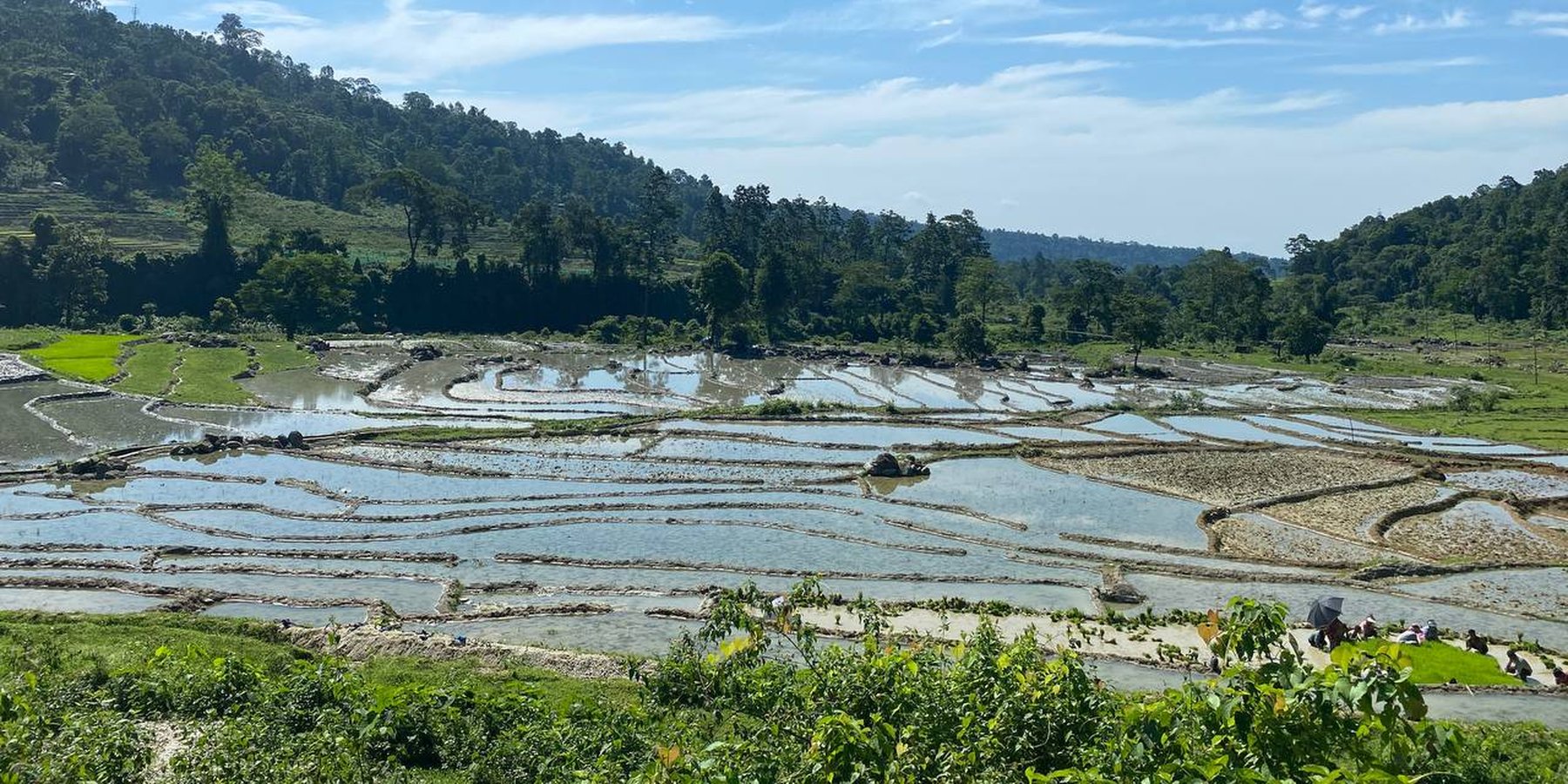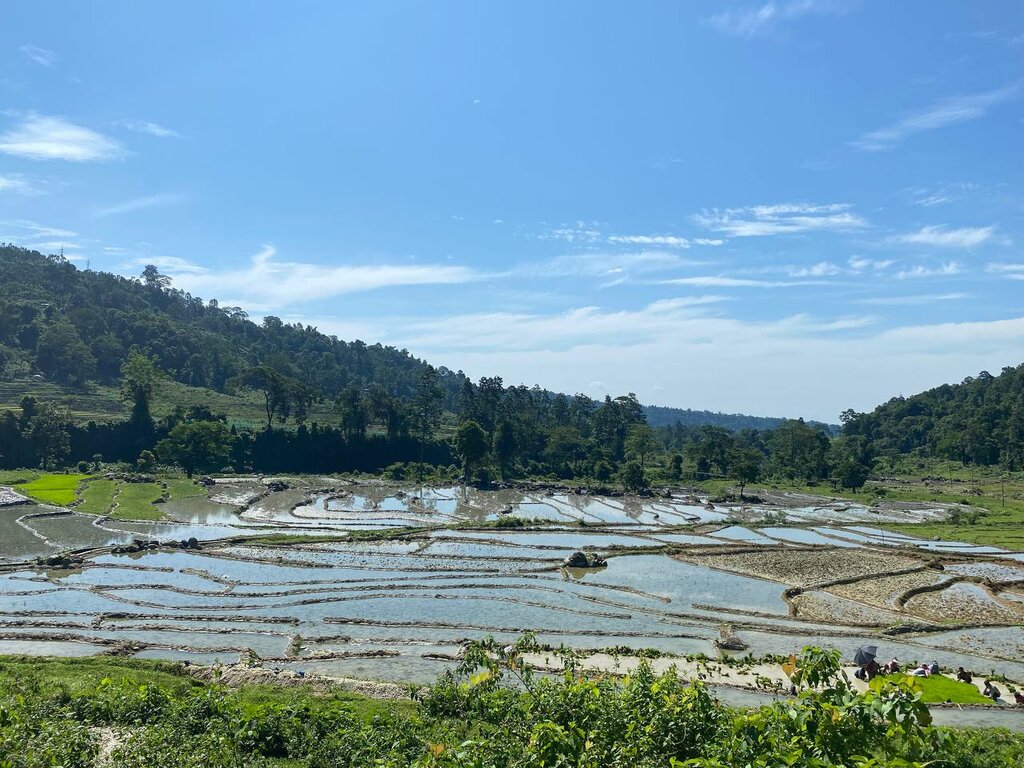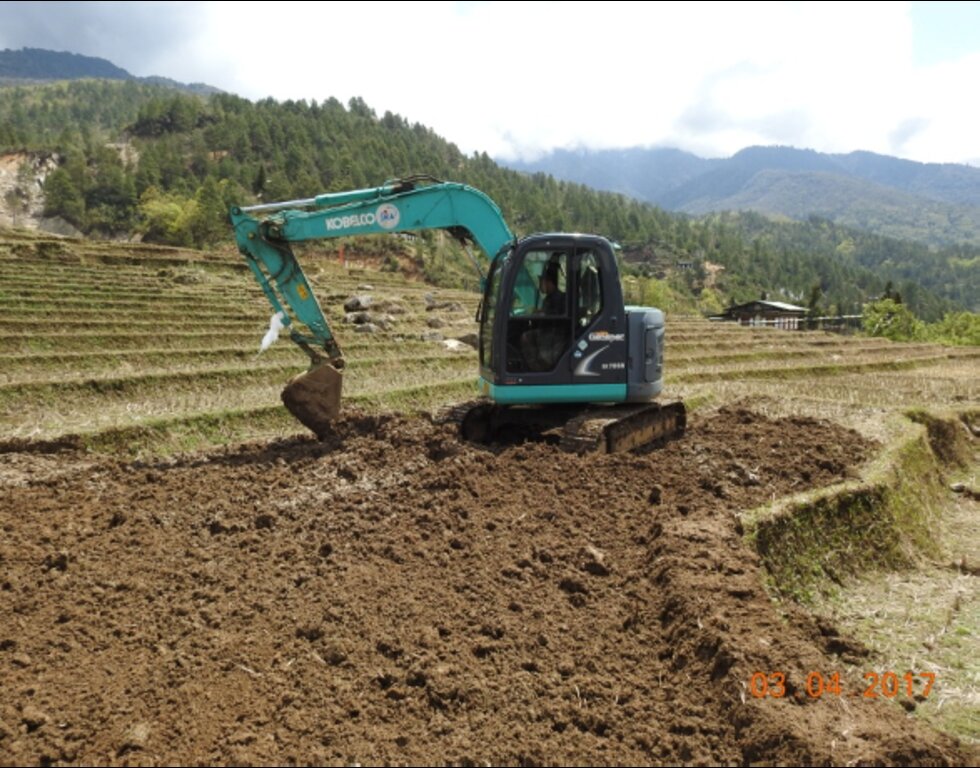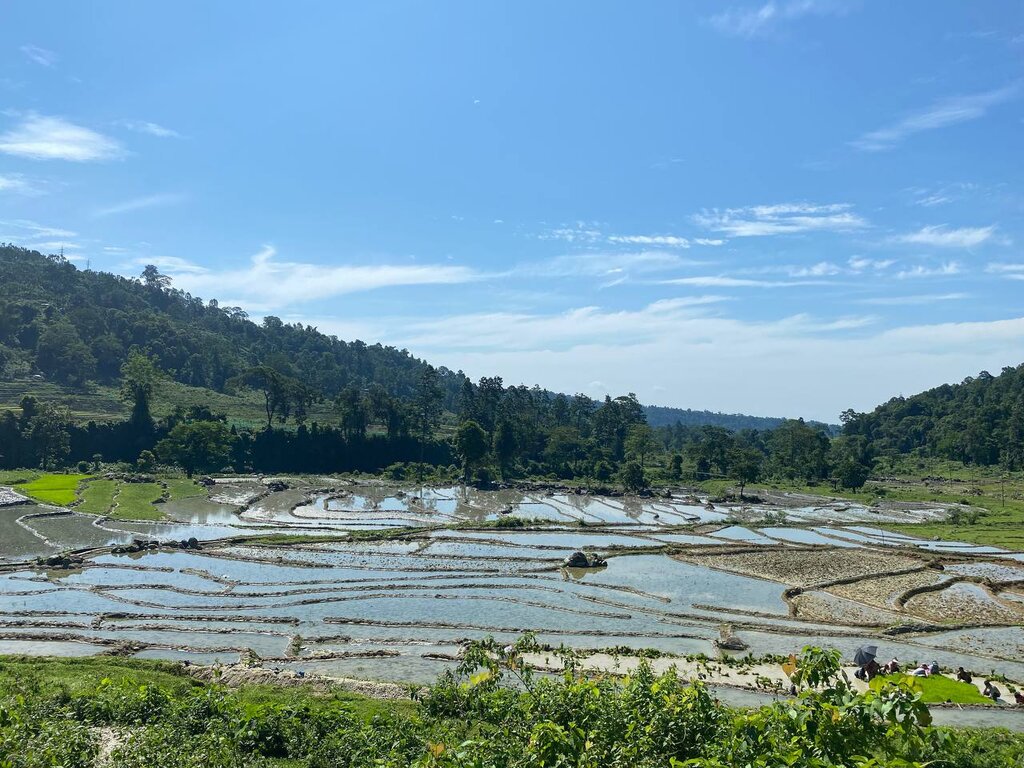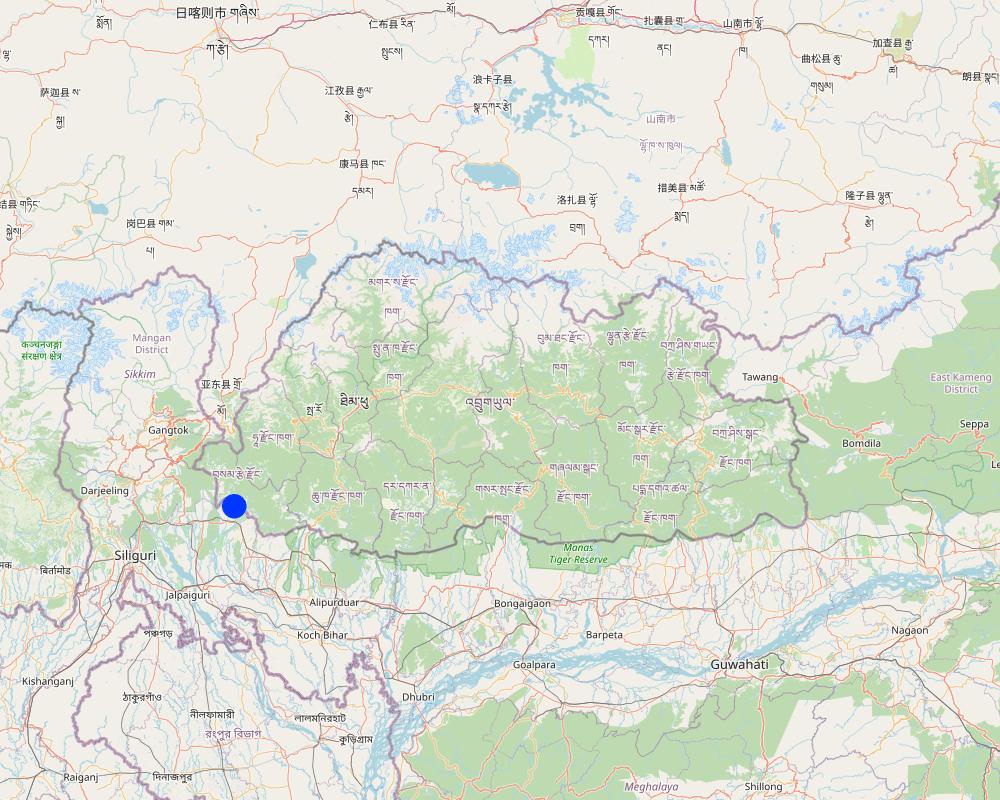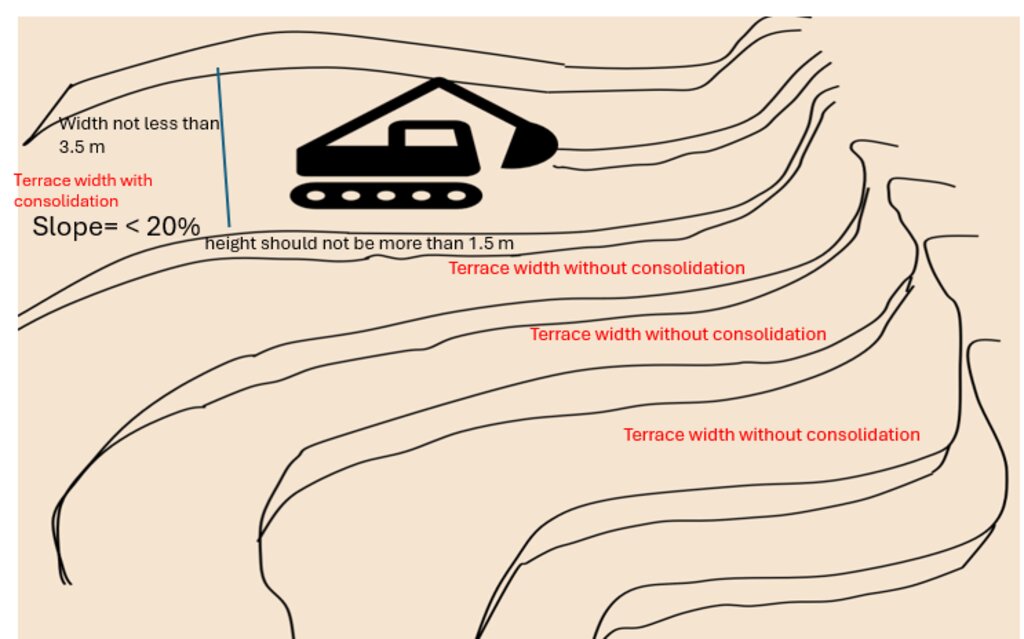Terrace Consolidation by Machine [Bhutan]
- Creation:
- Update:
- Compiler: Karma Wangdi
- Editor: Tashi Wangdi
- Reviewers: William Critchley, Rima Mekdaschi Studer
Aari Jakaed Tangni (ཨ་རི་བརྒྱ་བསྐྱེད་བཏང་ནི)
technologies_6871 - Bhutan
View sections
Expand all Collapse all1. General information
1.2 Contact details of resource persons and institutions involved in the assessment and documentation of the Technology
Key resource person(s)
land user:
Limbu Ram Bahadur
Sang-Ngag-Chhoeling village, Yoeseltse Gewog (Block), Samtse Dzongkhag (District)
Bhutan
Name of project which facilitated the documentation/ evaluation of the Technology (if relevant)
Strengthening national-level institutional and professional capacities of country Parties towards enhanced UNCCD monitoring and reporting – GEF 7 EA Umbrella II (GEF 7 UNCCD Enabling Activities_Umbrella II)Name of the institution(s) which facilitated the documentation/ evaluation of the Technology (if relevant)
National Soil Services Centre, Department of Agriculture, Ministry of Agriculture & Livestock (NSSC) - Bhutan1.3 Conditions regarding the use of data documented through WOCAT
The compiler and key resource person(s) accept the conditions regarding the use of data documented through WOCAT:
Yes
1.4 Declaration on sustainability of the described Technology
Is the Technology described here problematic with regard to land degradation, so that it cannot be declared a sustainable land management technology?
No
Comments:
This technology is one of the major land degradation mitigating measures
2. Description of the SLM Technology
2.1 Short description of the Technology
Definition of the Technology:
Terrace consolidation is the merging of existing narrow bench terraces into larger terraces to enable farm mechanization, commercial farming and crop intensification. This technology is promoted as the existing terraces are generally narrow and this limits efficient operation and utilization of land and other resources.
2.2 Detailed description of the Technology
Description:
Terrace consolidation involves merging of small terraces into larger terraces using a machine to make more efficient use of land through farm mechanization, commercial farming and crop intensification. This technology is promoted as the existing terraces are generally narrow and this limits efficient operation and utilization of land and other resources.
The consolidation of narrow terraces is recommended if the general slope of the proposed site is less than 20° (36%) with good soil drainage and low risk of land degradation. While consolidating narrow terraces, it is strongly recommended to remove the topsoil from the terraces and put it back once the levelling is completed. The consolidated terrace should maintain a maximum riser height of 1.5 m and bed width of 3.5 m. For slopes below 12° (21%), the bench width should not exceed 5–6 m.
Farmers can expand the amount of arable land available, maximize agricultural operations, and encourage sustainable farming methods for higher crop output and enhanced ecological resilience by converting narrower and more steep bench terraces into bigger ones (NSSC, 2020). A large portion of hillside farmers around the world rely on terracing. For the purpose of facilitating the growth of field crops, horticultural crops, fodder, and other crops that require specific management practices (e.g., irrigation), alone or in agroforestry systems, hilly or mountainous terrains are divided into narrow but graduated steps, typically 2-3 m wide and 50-80 m long across the slopes (Chapagain & Raizada, 2017).
Enlargement of terraces begins with a thorough survey and analysis of the topography and terrain. In order to build larger terraces with the least amount of environmental damage, this phase is essential. The next step in the construction process is to reshape the present, small terraces into larger, more open ones. To make wider terraced levels, this may entail moving soil and cutting through slopes. Furthermore, filling up the gaps and levelling the land's surface is required in order to reduce the number of risers and produce a continuous, gently sloping terrace. The installation of suitable drainage systems is also crucial to guarantee adequate water management and stop soil erosion.
Larger terraces enhance water management capabilities. With a more extensive surface area, water runoff is minimized, and the distribution of irrigation water becomes more even, promoting better soil moisture retention and reducing erosion. This, in turn, contributes to soil health and fertility, supporting sustainable farming practices. Moreover, the consolidation of smaller terraces into larger ones reduces the overall number of risers, thereby enhancing accessibility for farmworkers and farm machinery. This ease of access further optimizes the use of resources and fosters better crop management. Additionally, larger terraces can enable the implementation of crop diversification strategies, such as intercropping and crop rotation, promoting biodiversity and mitigating the risk of crop failure due to pests or adverse weather conditions.
However, the process of enlarging terraces involves altering the terrain, which can lead to soil erosion, habitat destruction, and ecological imbalances. This environmental impact may negatively affect local flora and fauna, reducing biodiversity and disrupting the delicate ecological equilibrium (Deng et al., 2021). Planning for safe discharge of excess water out of the terrace system effectively helps preserve soil fertility and reduces runoff. It is essential also to pay close attention to the preservation of the local ecosystem and biodiversity throughout the process.
2.3 Photos of the Technology
2.5 Country/ region/ locations where the Technology has been applied and which are covered by this assessment
Country:
Bhutan
Region/ State/ Province:
Samtse
Further specification of location:
Sang-Ngag-Chhoeling
Specify the spread of the Technology:
- evenly spread over an area
If precise area is not known, indicate approximate area covered:
- < 0.1 km2 (10 ha)
Is/are the technology site(s) located in a permanently protected area?
No
Comments:
Total area is 6 hectares
Map
×2.6 Date of implementation
Indicate year of implementation:
2021
2.7 Introduction of the Technology
Specify how the Technology was introduced:
- through projects/ external interventions
Comments (type of project, etc.):
The terrace consolidation activities in this community was funded by the Green Climate Fund (GCF) project for Land Consolidation
3. Classification of the SLM Technology
3.1 Main purpose(s) of the Technology
- improve production
- reduce, prevent, restore land degradation
- adapt to climate change/ extremes and its impacts
- mitigate climate change and its impacts
- create beneficial economic impact
3.2 Current land use type(s) where the Technology is applied
Land use mixed within the same land unit:
No

Cropland
- paddy
Number of growing seasons per year:
- 1
Is intercropping practiced?
No
Is crop rotation practiced?
No
3.3 Has land use changed due to the implementation of the Technology?
Has land use changed due to the implementation of the Technology?
- No (Continue with question 3.4)
Land use mixed within the same land unit:
No

Cropland
- paddy
Is intercropping practiced?
No
Is crop rotation practiced?
No

Settlements, infrastructure
- Settlements, buildings
- Traffic: roads, railways
- Energy: pipelines, power lines

Unproductive land
3.4 Water supply
Water supply for the land on which the Technology is applied:
- mixed rainfed-irrigated
3.5 SLM group to which the Technology belongs
- cross-slope measure
- wetland protection/ management
- ecosystem-based disaster risk reduction
3.6 SLM measures comprising the Technology

structural measures
- S1: Terraces
- S2: Bunds, banks
3.7 Main types of land degradation addressed by the Technology

soil erosion by water
- Wt: loss of topsoil/ surface erosion
- Wg: gully erosion/ gullying
3.8 Prevention, reduction, or restoration of land degradation
Specify the goal of the Technology with regard to land degradation:
- reduce land degradation
- adapt to land degradation
4. Technical specifications, implementation activities, inputs, and costs
4.1 Technical drawing of the Technology
Technical specifications (related to technical drawing):
consolidation of old and small terraces with machines
Author:
karma Wangdi
Date:
20/07/2023
4.2 General information regarding the calculation of inputs and costs
Specify how costs and inputs were calculated:
- per Technology area
Indicate size and area unit:
2.5 acre
If using a local area unit, indicate conversion factor to one hectare (e.g. 1 ha = 2.47 acres): 1 ha =:
1ha
other/ national currency (specify):
Ngultrum
If relevant, indicate exchange rate from USD to local currency (e.g. 1 USD = 79.9 Brazilian Real): 1 USD =:
80.0
Indicate average wage cost of hired labour per day:
500
4.3 Establishment activities
| Activity | Timing (season) | |
|---|---|---|
| 1. | Secure funding support from GCF | January (Before cropping) |
| 2. | Action planning in consultation with beneficiaries and the stakeholders | February (Before cropping) |
| 3. | Arrangement of excavator machine | First week of March (Before cropping) |
| 4. | Activity implementation | Second week of March till April (Before cropping) |
4.4 Costs and inputs needed for establishment
| Specify input | Unit | Quantity | Costs per Unit | Total costs per input | % of costs borne by land users | |
|---|---|---|---|---|---|---|
| Labour | Assisting operator (reaching fuel) | no | 60.0 | 500.0 | 30000.0 | 100.0 |
| Labour | Labelling of terraces | no | 60.0 | 500.0 | 30000.0 | 100.0 |
| Equipment | Hiring of Excavator | day | 6.0 | 20000.0 | 120000.0 | |
| Total costs for establishment of the Technology | 180000.0 | |||||
| Total costs for establishment of the Technology in USD | 2250.0 | |||||
If land user bore less than 100% of costs, indicate who covered the remaining costs:
This technology is been supported and funded by Green Climate Fund for land consolidation
Comments:
consolidation of old terraces is recommended only if the general slope of the proposed site is less than 20% with good soil drainage and minimal risk of land degradation. While consolidating small terraces into large terraces, the new terrace riser height should not be more than 1.5 m and width of the bench not less than 3.5 .For one ha there are around 34 small terrace which is consolidated to 18 terraces.
4.5 Maintenance/ recurrent activities
Comments:
No maintenance is done until now
4.6 Costs and inputs needed for maintenance/ recurrent activities (per year)
Comments:
Till date no maintenance was done
4.7 Most important factors affecting the costs
Describe the most determinate factors affecting the costs:
The major factor affecting the cost for implementing this technology is in hiring of excavator
5. Natural and human environment
5.1 Climate
Annual rainfall
- < 250 mm
- 251-500 mm
- 501-750 mm
- 751-1,000 mm
- 1,001-1,500 mm
- 1,501-2,000 mm
- 2,001-3,000 mm
- 3,001-4,000 mm
- > 4,000 mm
Specify average annual rainfall (if known), in mm:
1500.00
Specifications/ comments on rainfall:
The gewog experiences mostly heavy shower with annual rainfall ranging from 1500 mm to 4000 mm
Indicate the name of the reference meteorological station considered:
National Center for Hydrology and Metrology (NCHM), Bhutan
Agro-climatic zone
- sub-humid
Subtropical monsoon climatic zone
5.2 Topography
Slopes on average:
- flat (0-2%)
- gentle (3-5%)
- moderate (6-10%)
- rolling (11-15%)
- hilly (16-30%)
- steep (31-60%)
- very steep (>60%)
Landforms:
- plateau/plains
- ridges
- mountain slopes
- hill slopes
- footslopes
- valley floors
Altitudinal zone:
- 0-100 m a.s.l.
- 101-500 m a.s.l.
- 501-1,000 m a.s.l.
- 1,001-1,500 m a.s.l.
- 1,501-2,000 m a.s.l.
- 2,001-2,500 m a.s.l.
- 2,501-3,000 m a.s.l.
- 3,001-4,000 m a.s.l.
- > 4,000 m a.s.l.
Indicate if the Technology is specifically applied in:
- not relevant
5.3 Soils
Soil depth on average:
- very shallow (0-20 cm)
- shallow (21-50 cm)
- moderately deep (51-80 cm)
- deep (81-120 cm)
- very deep (> 120 cm)
If available, attach full soil description or specify the available information, e.g. soil type, soil PH/ acidity, Cation Exchange Capacity, nitrogen, salinity etc.
Soil Type: Sandy Loam
MC (%): 3.66
OM (%): 1.73
OC (%): 1.00
pH (H20): 6.60
EC (µs/cm): 28.37
N (%): 0.05
P (ppm): 0.73
K (mg/100ml): 82.77
5.4 Water availability and quality
Availability of surface water:
good
Water quality (untreated):
good drinking water
Is water salinity a problem?
No
Is flooding of the area occurring?
Yes
Regularity:
episodically
5.5 Biodiversity
Species diversity:
- medium
Habitat diversity:
- medium
5.6 Characteristics of land users applying the Technology
Sedentary or nomadic:
- Sedentary
Market orientation of production system:
- mixed (subsistence/ commercial)
Off-farm income:
- less than 10% of all income
Relative level of wealth:
- average
Individuals or groups:
- individual/ household
Level of mechanization:
- manual work
- animal traction
Gender:
- women
- men
Age of land users:
- children
- youth
- middle-aged
- elderly
5.7 Average area of land used by land users applying the Technology
- < 0.5 ha
- 0.5-1 ha
- 1-2 ha
- 2-5 ha
- 5-15 ha
- 15-50 ha
- 50-100 ha
- 100-500 ha
- 500-1,000 ha
- 1,000-10,000 ha
- > 10,000 ha
Is this considered small-, medium- or large-scale (referring to local context)?
- medium-scale
5.8 Land ownership, land use rights, and water use rights
- Family
Land use rights:
- communal (organized)
- individual
Water use rights:
- communal (organized)
- individual
Are land use rights based on a traditional legal system?
Yes
5.9 Access to services and infrastructure
health:
- poor
- moderate
- good
education:
- poor
- moderate
- good
technical assistance:
- poor
- moderate
- good
employment (e.g. off-farm):
- poor
- moderate
- good
markets:
- poor
- moderate
- good
energy:
- poor
- moderate
- good
roads and transport:
- poor
- moderate
- good
drinking water and sanitation:
- poor
- moderate
- good
financial services:
- poor
- moderate
- good
6. Impacts and concluding statements
6.1 On-site impacts the Technology has shown
Socio-economic impacts
Production
crop production
Comments/ specify:
Before the terrace consolidation they used to have minimum production but now they are producing for both self consumption and commercial purpose. these are expert estimates or data measured.
production area
Comments/ specify:
The merging of small terraces has increased the cropping area. These are expert estimates or data measured.
land management
Comments/ specify:
Overall Land management has become easier for them as they can use more machines due to larger flat terraces
Water availability and quality
irrigation water availability
Comments/ specify:
The do not have enough water for irrigation during the dry season.
demand for irrigation water
Comments/ specify:
The land has become larger and they need more irrigation compared to before the terrace consolidation.
Income and costs
expenses on agricultural inputs
Comments/ specify:
The deployment of number of labor has reduced with the intervention of farm machineries, thus reducing the cost of production with reduced time and man power. These are expert estimates or data measured.
farm income
Comments/ specify:
Farm income has increased compared to past as they have larger area of cultivation.
diversity of income sources
Comments/ specify:
The time and resources saved from this technology intervention has been beneficial in for other use. These are expert estimates or data measured.
workload
Comments/ specify:
Due to mechanized farming favoured by terrace consolidation, the workload at an individual level has significantly reduced. These are expert estimates or data measured.
Socio-cultural impacts
food security/ self-sufficiency
Comments/ specify:
The increased cropping area and contributed in increase in production, thus enhancing the food and nutrition security. These are expert estimates or data measured.
health situation
Comments/ specify:
The better crop productivity is found to be contributing better health quality of the farm household. These are expert estimates or data measured.
SLM/ land degradation knowledge
Comments/ specify:
Could have better understanding on SLM and its benefits through the sensitization programs. These are expert estimates or data measured.
Ecological impacts
Soil
soil loss
Comments/ specify:
The flat terraces has been always been adventitious in controlling overall soil and nutrient loss. These are expert estimates or data measured.
soil accumulation
Comments/ specify:
Because of very minimum soil loss, the soil accumulation rate in these terraces has been very high. These are expert estimates or data measured.
Climate and disaster risk reduction
landslides/ debris flows
Comments/ specify:
After they have reduce the riser and increased the terrace land there is less risk to landslide when the land becomes stable after the machine work.
6.2 Off-site impacts the Technology has shown
Specify assessment of off-site impacts (measurements):
there is no off-site impacts recorded for this technology
6.3 Exposure and sensitivity of the Technology to gradual climate change and climate-related extremes/ disasters (as perceived by land users)
Gradual climate change
Gradual climate change
| Season | increase or decrease | How does the Technology cope with it? | |
|---|---|---|---|
| annual temperature | increase | very well | |
| annual rainfall | decrease | not known |
Climate-related extremes (disasters)
Meteorological disasters
| How does the Technology cope with it? | |
|---|---|
| local rainstorm | very well |
| local thunderstorm | very well |
| local windstorm | very well |
Climatological disasters
| How does the Technology cope with it? | |
|---|---|
| heatwave | very well |
| cold wave | very well |
| extreme winter conditions | very well |
| drought | not well |
6.4 Cost-benefit analysis
How do the benefits compare with the establishment costs (from land users’ perspective)?
Short-term returns:
positive
Long-term returns:
positive
How do the benefits compare with the maintenance/ recurrent costs (from land users' perspective)?
Short-term returns:
positive
Long-term returns:
positive
6.5 Adoption of the Technology
- 1-10%
If available, quantify (no. of households and/ or area covered):
8 households
Of all those who have adopted the Technology, how many did so spontaneously, i.e. without receiving any material incentives/ payments?
- 0-10%
6.6 Adaptation
Has the Technology been modified recently to adapt to changing conditions?
No
6.7 Strengths/ advantages/ opportunities of the Technology
| Strengths/ advantages/ opportunities in the land user’s view |
|---|
| Increased production |
| Enhanced farm mechanization and workability |
| Strengths/ advantages/ opportunities in the compiler’s or other key resource person’s view |
|---|
| Reduced surface runoff |
| Optimal use of resources |
| Increased production |
| Enhanced farm mechanization and workability |
6.8 Weaknesses/ disadvantages/ risks of the Technology and ways of overcoming them
| Weaknesses/ disadvantages/ risks in the land user’s view | How can they be overcome? |
|---|---|
| cost for terrace consolidation | help and support through government and projects |
| Weaknesses/ disadvantages/ risks in the compiler’s or other key resource person’s view | How can they be overcome? |
|---|---|
| Heavy and large machineries (excavator) used to carry out terrace consolidation might pose soil compaction and sealing | Use of smaller excavators specifically designed for terracing |
7. References and links
7.1 Methods/ sources of information
- field visits, field surveys
4
- interviews with land users
1
When were the data compiled (in the field)?
20/07/2023
7.2 References to available publications
Title, author, year, ISBN:
BHUCAT, NSSC, 2011
Available from where? Costs?
Website
7.3 Links to relevant online information
Title/ description:
Agronomic Challenges and Opportunities for Smallholder Terrace Agriculture in Developing/ Countries/
URL:
https://doi.org/10.3389/fpls.2017.00331
Title/ description:
Advantages and disadvantages of terracing/A comprehensive review. International Soil and Water Conservation Research
URL:
https://doi.org/10.1016/j.iswcr.2021.03.002
Title/ description:
PARTICIPATORY SLM ACTION PLAN 2020 /Supporting Climate Resilience and Transformational Change in the Agriculture Sector in Bhutan Funded by Green Climate Fund.
URL:
https://www.bhutangcf.gov.bt/wp-content/uploads/2021/12/SLM_Action-Plan_2020.pdf
Title/ description:
Soil and Water Conservation / Lesson 5 Terraces for Water Erosion Control
URL:
http://ecoursesonline.iasri.res.in/mod/page/view.php?id=2098
Links and modules
Expand all Collapse allLinks
No links
Modules
No modules


